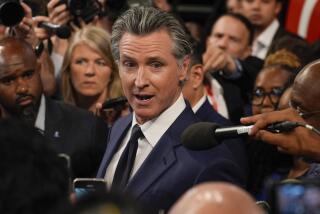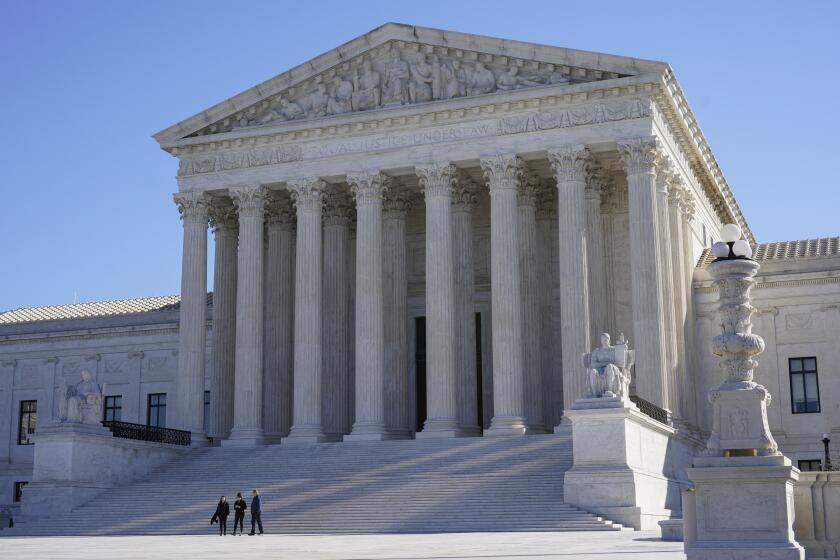Gov. Davis’ Budget Blueprint Lacks Nerve
- Share via
On Wednesday, Gov. Gray Davis delivered his state-of-the-state address, vowing to bring “substantial structural reform” to California’s tax system. On Friday, he delivered his budget plan, which was essentially devoid of what he had promised two days earlier.
In short, Davis took the easy way out in his blueprint for closing the state’s yawning budget deficit.
The governor called for a hike in income taxes on the highest-earning Californians; tacked 1% onto the sales tax statewide; and shifted more burdens onto county government, including caring for drug addicts and the mentally ill.
In a message included with his budget, Davis talked about convening a bipartisan legislative panel in February to take a serious look at “reforms to California’s fiscal structure,” which he branded as obsolete. But for now, those reforms remain missing.
Discounting all the rhetoric, Davis’ plan is strikingly similar to one forged about a decade ago by Gov. Pete Wilson, who faced a budget deficit proportionately as large as today’s.
Back then, “we added a percent onto the income taxes for the highest brackets ... and cut back some programs,” recalls Philip Romero, who was economic advisor to Wilson and is now dean of the Lundquist College of Business at the University of Oregon.
The strategy worked -- that is, until California hit hard times again.
And though Davis speaks of ending “the budget roller-coaster ride” that California has been on, his plan will do only what Wilson’s did: provide a temporary fix.
What the governor should have done is attempted to broaden the tax base instead of deepening it. Specifically, a tax on services could be levied on the fees that lawyers and accountants charge, medical services, auto repairs, dry cleaning and a host of other daily transactions.
Under Davis’ proposal, however, the sales tax would continue to be collected only on goods. So, if you buy a hair clipper or home permanent kit at the drugstore, you would pay a tax. But if you get a haircut from a barber or beautician, you wouldn’t.
“It’s not rational,” says Ross DeVol, economist at the Milken Institute in Santa Monica.
Another measure Davis should have proposed is a tax on Internet sales -- despite the political firestorm that he surely would have faced from Silicon Valley. “Why should you pay a tax if you go the store, but not if you buy the same goods online?” asks Rick Cole, Azusa city manager and a noted urban affairs expert.
Above all, what Davis really needed to include in his budget was a hard-and-fast measure that would have forced a rethinking of Proposition 13, which capped increases in property taxes starting in 1978. In his written message, Davis did acknowledge that Proposition 13 is one of the issues that should be on the table at his February powwow.
But he should have tackled Proposition 13 now by including a plank in his budget to allow for the reassessment of commercial property.
Indeed, it’s Proposition 13 that has forced California to rely on personal income taxes more than any other state does -- to the tune of 45% of its $100-billion annual state expenditure. But income taxes are not ideal for financing government because they rise too much in good times and shrink too precipitously in bad times.
Getting the state’s fiscal house in order -- not only for the short term, but also for the long haul -- is crucial. For business to thrive here, California must offer a stable financial climate.
The state also must be able to meet the key infrastructure needs -- from roads to schools to water systems -- of a rapidly expanding population.
“We need stability,” says Oakland Mayor Jerry Brown, who was California’s governor from 1975 to 1983 with none other than Gray Davis acting as his chief of staff for six of those years.
In particular, Brown called for the state to “enhance the flow of capital” to the cities, something difficult to achieve at a time when California’s coffers are projected to come up nearly $35 billion short over the next 18 months.
Given the enormity of the deficit, some maintain that Davis had little choice but to sidestep the most controversial areas in presenting his budget. “Mixing structural tax reform and emergency measures to balance the budget is not a good idea,” says economist Stephen Levy of the Palo Alto-based Center for the Continuing Study of the California Economy.
Others fear that by putting everything off until February -- and even then calling for discussion and consultation, not firm action -- Davis may never achieve what needs to get done.
At this point, says Cole, “it’s all in the follow-through. We should encourage this rather than assume that it’s more of the same from Davis. It would be great if it’s not.”
James Flanigan can be reached at jim.flanigan@ latimes.com.
More to Read
Get the L.A. Times Politics newsletter
Deeply reported insights into legislation, politics and policy from Sacramento, Washington and beyond. In your inbox twice per week.
You may occasionally receive promotional content from the Los Angeles Times.










